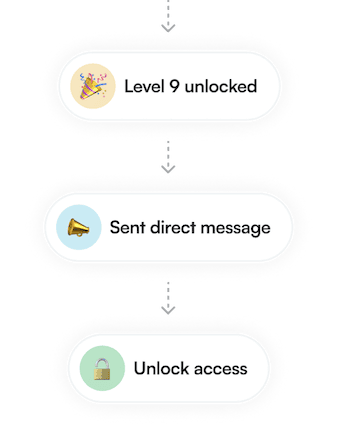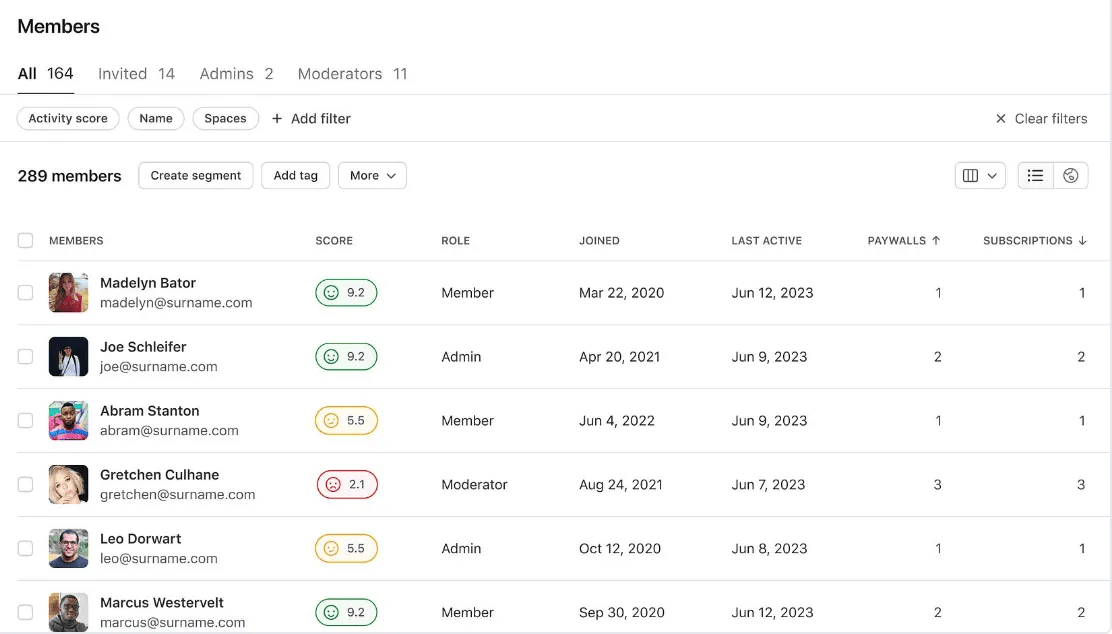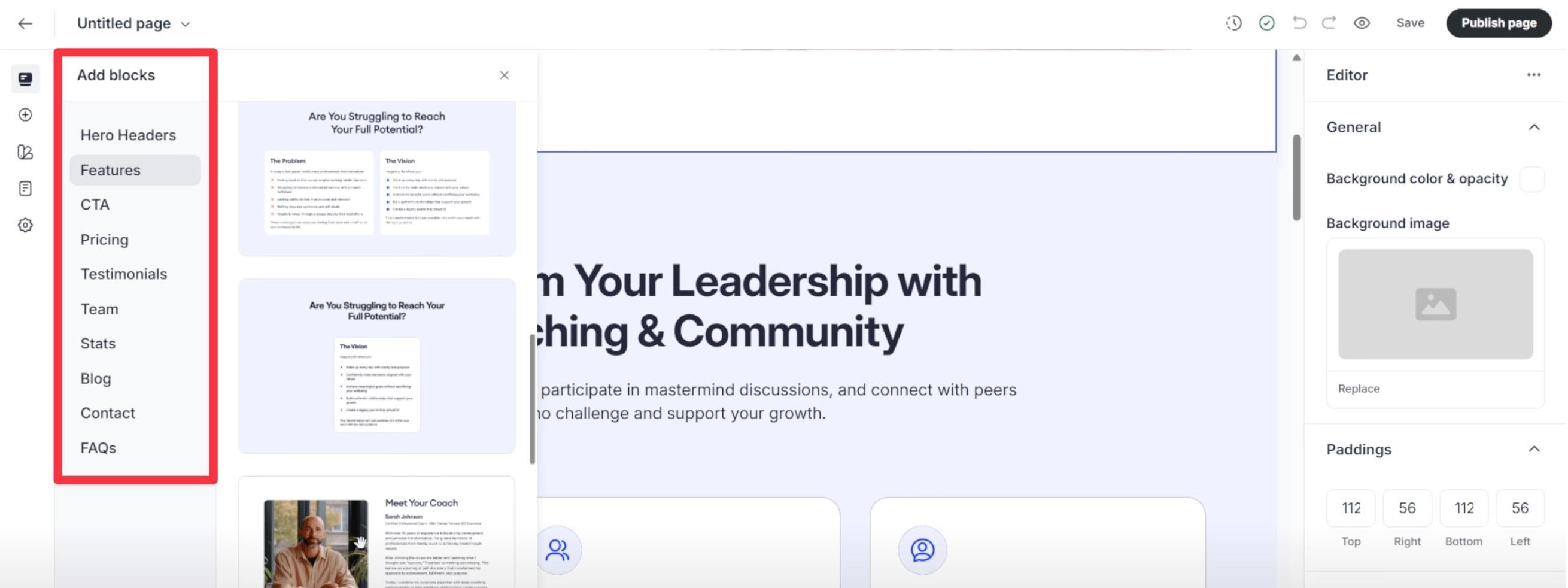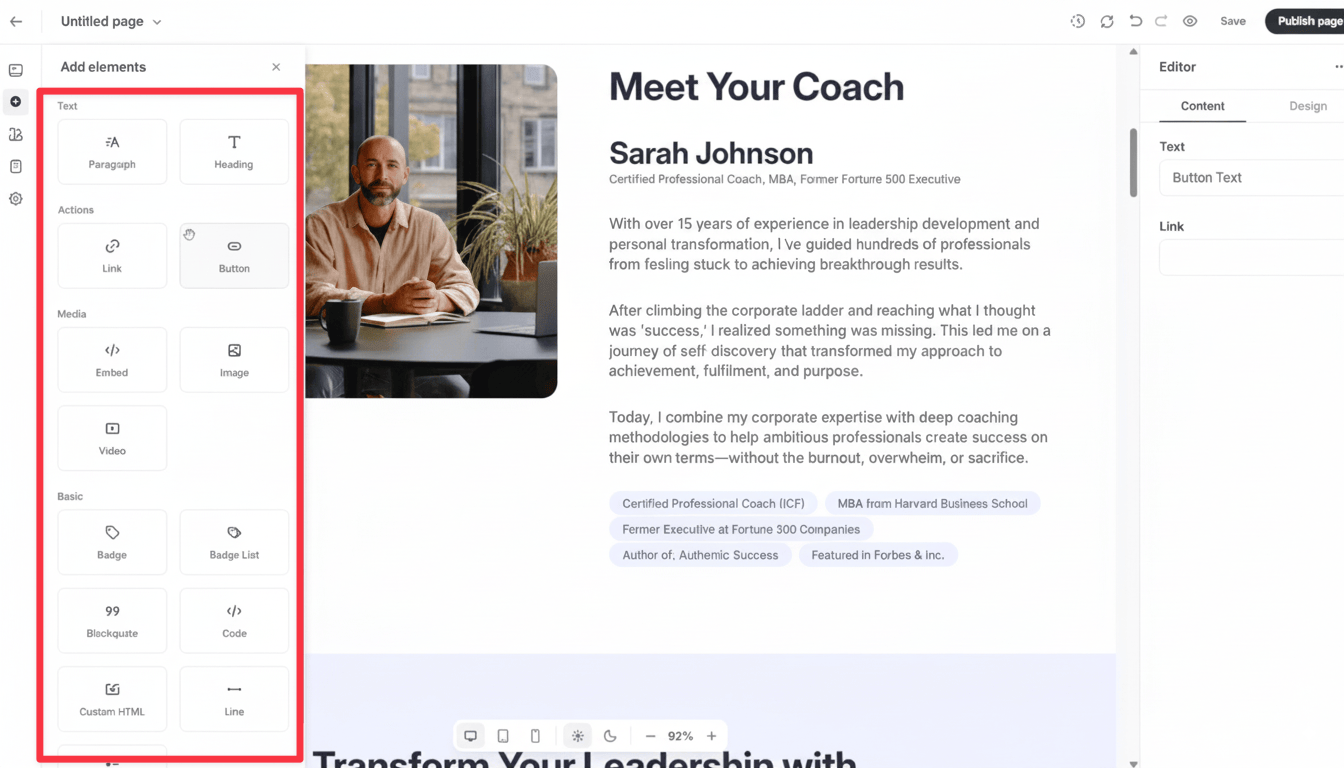So, I’ve been using Kajabi for the past 2 to 3 years, and recently, I started exploring Circle too.
And, I thought this is would be the right time for me to compare them!
In this comparison, I’ll mainly focus on course creation, funnel building, and communities.
In the past, choosing between these tools was relatively simple.
However, now it’s more challenging than ever before
Why?
Kajabi has significantly stepped up their community features (adding gamification).
And Circle? They’ve introduced automation workflows.
Let’s start with an overview!
| Features | Circle | Kajabi |
| Starting price | $89/mo | $89/mo (decoy) |
| Transaction fees | Hidden transaction fees not shown on pricing – costs you extra money | 0% |
| Mobile apps | iOS and Android | iOS and Android |
| Courses | Yes (more coming soon) | Yes (more features) |
| Communities | Yes | Yes (more gamifified) |
| Explore 👉 | 🔗 Explore Circle | 🔗 Explore Kajabi |
Overview

Kajabi was founded in 2010 by Kenny Rueter when he faced difficulty monetizing videos on YouTube.
Right from day one, Kajabi is into helping people turn their knowledge into profit.
But.
Today it offers various features such as the ability to:
- Selling online courses
- Coaching
- Host podcasts
- Communities
- Email marketing
👉 One of the strongest features of Kajabi is its automation engine, which allows you to seamlessly integrate all the provided features in one platform, similar to having Zapier within Kajabi.
Over the years, Kajabi has raised significant funds and is currently valued at around $2 billion. This has enabled them to scale their team and make strategic mergers and acquisitions to roll out impressive features.
They are sitting on cash! 💰

On the other hand, Circle is an all-in-one community platform founded in 2019 by Sid Yadav, who was Teachable’s first designer. It was later backed by Ankur Nagpal, the first for Teachable, when Teachable was sold to HotMart in 2020.
Circle has gained significant traction due to its track record and is currently valued at $200 million.
In fact it’s the best community platform I recommend!
Circle is a modern tool that’s super easy to use – it’s built from scratch with simplicity in mind.
You know those apps like Notion and Slack that just make sense?
Circle follows that same modular approach.
Unlikeother conventional community platformssuch as Mighty Networks, Circle places extreme emphasis on UI/UX, integrations, and automations.
Quick decision
What do we like about Circle over Kajabi 👍?
- Intuitive UI/UX: Circle’s interface is clean and user-friendly. If you’re already familiar with platforms like Slack or Notion, you’ll feel right at home.
- Modular features: Circle is a flexible platform that allows you to build a community that fits your vision. It provides building blocks for various layouts like post view, list view, and card view, to customize how a particular space should look. Think of Notion, but for communities.
- Embed widget: With Circle, you can embed spaces or groups on other platforms, such as WordPress or even Teachable, to promote and motivate students to join the spaces.
- Community moderation: Circle comes with security features like keyword blockers and profanity checkers, essential for preventing spam in large communities.
What do we like about Kajabi over Circle 👍?
- All-in-one platform: Kajabi not only provides the ability to create courses and communities, but also offers website building, funnel building, email automation, and feature-rich marketing functionalities, making it a comprehensive platform.
- Stronger Automation Engine: While Circle also comes with an automation engine (trigger-action), but with Kajabi (as it has got dozens of features) the possibilities are endless.
- Specialist course features: Kajabi’s main forte lies in its highly advanced course creation capabilities. You can build various types of courses, assessments, issue certificates, and student level progress tracking with heatmaps and retention graphs.
- Sales and marketing: Kajabi has powerful marketing and sales automation tools like email marketing, sales funnels, pipelines, landing page creation, user segmentation, automation rules, and A/B testing.
- Community gamification: Kajabi acquired Vibely to enhance online community engagement. It provides features like points, leaderboards, challenges, live rooms, and events (no need of 3rd party integrations). It’s even ahead of Circle here!
Similarities ⚖️
- Email automation: They both come with the ability for you to send out broadcasts and email sequences right within the platform based on various triggers and conditional filters.
- Automation features: Both of these tools have excellent automation engines to run various workflows. Based on triggers, you can execute actions, thus making your course and community management more efficient.
- Premium platforms: Both Kajabi and Circle are premium platforms. They are not cheap – if you want to get access to all their automation features, you need to shell out around $200 per month.
Upfront verdict
Kajabi is truly the Swiss Army knife, if you ask me.
It seamlessly integrates website building, landing pages, email marketing, courses, and community – all under one roof.
Not only does it have a good breadth of features, but there is also a real depth to it. For example, the gamification features with their community module are truly exceptional.
Also, the big part is that.
Their powerful automation engine connects everything, creating workflows that actually save you time.
Now.
Circle has evolved from community-first to an “ambitious” all-in-one platform.
Their recent email marketing rollout shows they’re serious about competing with Kajabi.
But here’s the reality:
For pure value, Kajabi edges out Circle in 2025. Not only does it offer more comprehensive features, but Circle’s crucial Automation Workflows are locked behind their $199/month plan (add add email marketing addon on top) – making Kajabi the more cost-effective option for serious creators.
👉 Ready to get started? Check out the special offers for BloggingX readers: Try Kajabi with an extended 30-day free trial or Get 20% off your first year with Circle
Community
Community organization
Kajabi and Circle both include built-in communities.
More recently, Kajabi acquired Vibely, an online community-building tool for creating highly engaging communities.
Kajabi has “access groups: for managing membership levels:
- Circles: Chat rooms for discussions
- Challenges: Activities to boost engagement
- Meetups: Scheduled online/offline events
- Announcements: Important community updates
Here’s a real example: Say you create a “Diamond members” group – these folks get special access to all the good stuff like exclusive challenges, circles, meetups, and announcements.

In Kajabi, you get to pick between two different setups for your Circles:
- Feed layout: Works like a forum where people can have longer discussions
- Chat layout: This one’s more like Slack or Discord
So yeah, Kajabi’s circles give you that perfect mix of community vibes and casual chat feels.
Now, Circle takes a different approach.

Each community can comprise multiple groups, and these groups can further include numerous spaces, such as posts, chat, events, and courses.
Unlike Kajabi’s separate course function, Circle integrates courses as a “space type”, and this can clutter the sidebar as both courses and discussion areas end up in the sidebar.
Community gamification
Kajabi, with its acquisition of Vibely, has implemented a lot of gamification features.

It includes a feature for creating activity-based “Challenges” for specific groups.
Members can upload proof of completion and earn points based on their interactions.

Also, based on the points they get, you can provide them with badges and feature them on the leaderboards.Hello
For more inspiration on how to utilize these features, check out some Kajabi community examples I published in another blog.
Now with Circle:
Circle also has rolled out a game-changing gamification system with their 3.0 update.
Members earn points for all kinds of community actions – answering posts, showing up at events, or finishing course assignments.
The system has:
- Points and rewards: Members collect points for active participation that actually matter
- Leaderboards: Shows who’s most engaged, creating friendly competition

And as a community admin, you can set up custom rewards and trigger automated workflows when members hit certain achievements.
There’s also their “Activity Scores” feature that measures engagement quality.

What makes this really useful is that these scores aren’t just random numbers – they’re benchmarked against data from other Circle communities, so you know exactly how your engagement stacks up.
👉 Note on community moderation: Circle excels with profanity filters, flagging systems, and spam prevention tools, essential for maintaining healthy large communities. Kajabi lacks these features, though this may be less important since Kajabi communities tend to be smaller, paid groups rather than large public forums.
🏆 Winner: It’s a tie! Kajabi excels with Vibely’s robust engagement features, while Circle dominates moderation tools for larger communities. Choose based on your specific needs.
Course creation 📚
Kajabi has good course creation features and is more comprehensive compared to Circle.

When it comes to organizing your course material, you have modules, sub-modules, and the ability to have lessons/quizzes under them.

When you create a lesson in Kajabi, it can either be a video lesson, audio lesson, or an assessment.
For any lesson that you create, you can upload a checklist or any downloadable to accompany it.

Also, Circle allows you to create different sections and lessons within them.
When it comes to adding course content, both support text, images, audio/video, and files.

Here’s what makes Circle stand out – you can add any type of content block to your lessons, plus custom HTML if you’re into that.
Just like Kajabi, you can drip-feed content to keep students from binging everything at once.
Speaking of drip-feeding – both platforms let you control exactly when students get access to new content.
Now, Kajabi’s got some extra things:
- Provides completion certificates for your students
- Makes sure students finish each module before moving on (no skipping ahead!)
- Uses graded quizzes as checkpoints – gotta pass to move forward
- Lets you run live coaching sessions right in the platform
- Shows you detailed stats about how your students are doing (super helpful for tracking progress)
🏆 Winner: Kajabi. Kajabi has advanced course builder features, including certificates, content locking, assessments, video analytics, and AI content creation. Circle’s course features are roughly half as comprehensive as of now.
Live streaming
Looking for a platform that handles live events?
Let’s break down how Circle and Kajabi stack up.
Circle nails the live streaming game with good flexibility!
You can host up to 1,000 participants in a live stream and up to 30 people in interactive rooms.
Pretty impressive, right?

What makes Circle stand out is how many ways you can go live:
- Native streaming: Run everything directly in Circle without jumping to other tools
- Third-party options: Prefer Zoom or YouTube Live? No problem – Circle plays nice with these tools
Also, the audience can conveniently join the events from their mobile.
Circle’s community-first approach means your events, chats, and content all live together in organized spaces. This creates a more engaging experience for everyone.
Now let’s talk about Kajabi.
Kajabi takes a different approach with its “Live Rooms” feature. These rooms come packed with useful tools:
- Video recording: Save your sessions for members who couldn’t attend
- Screen sharing: Perfect for demonstrations and presentations
- Breakout groups: Split large sessions into smaller discussion groups
- Video chat with emojis: Adds a fun interactive element
The big limitation?

Kajabi caps attendance at 200 participants. That’s fine for most coaching sessions but might not work for larger webinars.
Now let’s talk about Kajabi.
Here’s where Kajabi truly shines: you can schedule live events directly inside your courses. This feature is actually pretty unique and boosts attendance since members can register while going through course content.
🏆 Winner: If you need to host large-scale events (1,000+ people) with flexible setup options, Circle is your best bet. But if you’re primarily teaching courses and want seamlessly integrated live sessions with features like breakout rooms, Kajabi has the edge – even with its 200-person limit.
Website and page builder
With Kajabi, you can build your entire website using their 10+ different course and site themes that have a professional and modern look.

Additionally, Kajabi provides a feature-rich page builder with over 40+ different modules to design your pages.

While Kajabi’s page builder is more powerful, some may find it lacking in flexibility. However, for non-developers, it offers more than enough customization options.
Now, Circle!
With their recent 3.0 update, it now has its own website builder.
You can create landing pages and simple websites right inside the platform.

They give you templates for different niches to choose from. After picking one, you can customize sections using pre-made blocks.

The builder is pretty basic though. You get simple elements like paragraphs, headings, links, and buttons.

Good news is they included a Code widget so you can add custom HTML for things like opt-in forms.
🏆 Winner: Kajabi. It offers a more robust website builder with more elements, blocks, and design options. While Circle’s recently launched website builder is functional for basic needs, it’s still limited compared to Kajabi’s more comprehensive solution that provides greater customization options.
Sales and checkout options 💲
With Circle, you can easily charge your community and accept payments instantly using paywalls.

With Paywalls you can:
- Charge bi-weekly, monthly, quarterly, or annual subscriptions.
- Offer various membership tiers with different pricing plans.
- Charge for private spaces and accept one time payments.
When it comes to checkout, Circle keeps things super basic – just a one-step checkout that only works with Stripe. No PayPal, no other payment options. That’s it.

Here’s the thing – Circle’s checkout is pretty basic.
You can’t add order bumps or upsells to make more money from each sale. And unlike Kajabi, you can’t even add social proof like testimonials to convince people to buy.
👉 Want better checkout features? You’ll probably need to use dedicated platforms like Thrivecart or SamCart. These give you more payment options and better conversion features.
Now, Kajabi keeps things simple with a built-in checkout that just works:

What’s cool is that you can make your checkout pages look exactly how you want them. Their page builder lets you drag and drop different elements to create something that matches your style.
Here’s where it gets really good – Kajabi lets you add upsells, downsells, and order bumps to make more money from each sale.
Circle?
Well, they’re missing the order bump feature, which is kind of a bummer if you’re serious about maximizing your sales.
🏆 Winner: Kajabi. With better checkout experiences, multiple payment gateways, and conversion-focused features like order bumps and upsells, Kajabi clearly outperforms Circle’s basic checkout system.
Automations

Circle recently introduced the automation workflows feature in their business plan.

This feature enables you to run triggered automation, perform bulk actions, and schedule various bulk actions on your site.
For example, if a particular person completes a specific course, then you can automatically send them a direct message.

It also provides different templates for creating automation workflows, similar to Zapier.
Kajabi, as an all-in-one platform, has an automation engine that connects all its functionalities.

In the above screenshot, you can see that when BloggingX Gold Membership offer is purchased, I can do actions like:
- Grant an offer
- Sending an email.
- Registering for an event (maybe onboarding webinar).
- Add a tag.
- Subscribe to the sequence

On its higher plans, Kajabi gives access to advanced automations. These come with an additional “conditional” filter to further specify the rules.
🏆 Winner: Kajabi, hands down. It comes with more numbers of triggers and actions and even conditional filters. It offers more features compared to Circle’s recently rolled out automation features.
Funnels
Also, as Kajabi comes with a landing page and website builder, you can create entire funnels inside it.
For example, when you create a new funnel, you will be presented with a blank canvas in which you can link various landing pages, offers, and emails together, similar to how you do in any email marketing software like ConvertKit or Active Campaign.

For instance, in the above screenshot, you can see that whenever a person opts into my email list, they will automatically be sent an email sequence delivering my course content.
Then, they will be redirected to the thank you page to nurture them further down in the funnel.
To accomplish the same with Circle:
You need to connect it with other funnel builder platforms like ClickFunnels, WordPress (with CartFlows and Elementor), or preferably Thrivecart, which I personally use.
If you’re looking for more insights on effective sales funnels, check out the best sales funnels for coaches.
Then, whenever a purchase occurs in your funnel, you need to use Zapier to add them to Circle.
🏆 Winner: Kajabi. It offers built-in funnel creation tools with visual workflow builders, while Circle requires third-party integrations and Zapier connections to achieve similar functionality.
Email marketing
Kajabi allows you to set up either email broadcasts or follow-up sequences.

When you create a broadcast or a sequence, there are various email templates from which you can choose.

Additionally, Kajabi email marketing offers a visual drag-and-drop email builder. This tool includes a variety of building blocks, such as text, images, buttons, and conversion-friendly widgets like videos, countdown timers, and social icons.

The best part is that Kajabi, as an all-in-one platform, also comes with an automation engine. You can set various automation rules.
For example, when a specific email link is clicked, you can automatically register your users for a webinar, thus enabling a one-click webinar registration functionality.
Now:
Circle recently introduced email marketing capabilities with the introduction of Circle Marketing Hub.

As of now, it comes with features like:
- Email broadcasts
- Marketing automations based on triggers from member actions
- Multi-step email journeys with timed delays
- Triggers based on user behavior
When it comes to pricing, for 10,000 subscribers, it costs $99 (cheaper than ConvertKit though).

If you are looking to hook circle with your other existing email marketing software, the sad thing with Circle is that it integrates only with Zapier.
🏆 Winner: Kajabi. It offers a complete email marketing solution with advanced automations built-in, while Circle’s Marketing Hub requires additional fees based on subscriber count.
Mobile app 📲


Kajabi and Circle both have well-rated mobile apps for Android and iOS.
The apps aren’t white-labeled, unlike Mighty Networks.
With these apps, students can:
- Consume courses on the go.
- Access communities and memberships.
- See all the product updates.
- Take quizzes, assessments, and download the attachments.
To increase conversions, both support in-app purchases and push notifications.
As an added advantage, Kajabi also has an app for especially creators. You can manage your entire business on the go.
🏆 Winner: Kajabi. Apps support in-app purchases. There is also a creator app available to manage your business on the go.
Integrations
When it comes to integrations, Circle has some catching up to do.
Right now, they only work with Zapier for most integrations. But they are serious on automations and integrations.
Here’s something useful – Circle does offer single sign-on options with platforms like MemberStack, MemberSpace, WordPress, Teachable, and others.
Kajabi, on the other hand, is way ahead in this game. They’ve got tons of direct integrations besides just Zapier.
You can easily connect it with payment processors like PayPal and Stripe, plus popular email tools like ActiveCampaign, Drip, ConvertKit, MailChimp, and even Typeform. Pretty neat, right?

🏆 Winner: Kajabi. It has more native integrations compared to Circle.
Pricing
Let’s look at Kajabi:
Its premium pricing starts at $89/month.

Their basic plan only supports 3 products and funnels. That’s why most people go for the Growth plan at $199 per month instead.
With this plan, you can create up to 15 products and funnels – perfect for most users.
Need a code editor because you’re a developer? You’ll want to pick their Pro plan at $399/month.
Now:
Circle’s pricing starts at $89/month – a solid deal if you just need the community features.

If you want all the good stuff like workflows and API access? You’ll need the $199 Business plan – but here’s the catch – you only get limited workflows.
You’ll need to pay up $419 per month for their Enterprise plan if you want unlimited workflows and better tracking tools.
3 shady things:
- All their plans are billed annually (see the asterisk *)
- The transaction fee is not disclosed in the pricing page.
- They don’t clearly mention how many workflows you actually get with their Business plan.
⚠️ Both of the platforms come with email marketing abilities. However, with Circle based on the number of contacts you have, you need to shell out additional money. For example, if you have 10,000 contacts, it costs you $99 per month.
Conclusion
After testing both platforms hands-on for years, here’s my honest take on Circle vs. Kajabi 2.0:
If you’re all about building a strong community and already have tools for courses and marketing, Circle is your friend. It’s modern, easy to use, and costs less to start.
Its community features are top-notch, but you’ll need to connect other tools to run your entire business.
On the other hand, Kajabi works as an all-in-one platform with courses, community, email marketing, and funnels bundled together.
With built-in marketing tools like upsells and order bumps, powerful automation options, and many direct integrations, it’s built for serious business owners who want everything in one place.






